We’re sailors and we know our knots. We don’t use bungees to avoid lashings or because we don’t have enough old rope lying about to tie things down. We’ve had too many snap or stretch over time to trust them for anything important. But we do like them to stop sail covers from flapping, secure a just-lowered jib against the stanchions, keep loose halyards from slapping, and organize coiled shrouds of a small boat sitting on its trailer with the mast down. They provide tension around the edge of a canvas cover or a steady return pull on slack tackle, such as an adjustable outhaul or genoa lead. The trouble is, some bungees barely make it through one sailing season.
Cheap cords are made from natural or cheap synthetic rubber, covered with a polypropylene cover. With a UV resistance that ranks near the bottom of the scale, polypropylene is a terrible choice for a bungee cover. After the cover fails, UV attacks the vulnerable natural rubber core. If you’re in luck, the cord just loses tension. In a worst case scenario, the cord snaps and tries to take your eye out.
Better cords use nylon or polyester covers and EPDM or polyurethane cores. There are also solid cords with no cover made from EPDM or polyurethane.
Pre-made cords come with hooks on the end. Some hooks are sturdy metal or nylon affairs, and some are cheap plastic that snap or slide off. Or perhaps you need a cord made to length for a rigging or canvas application. You might secure the ends with knots, hog rings, or one of many proprietary fittings that grasp the cord.
Safety tethers are slightly different cases, as are many cockpit bags with sewnin elastic. Often these use flat elastic used in the garment industry, and these generally fail within 3-5 years, even with some protection from the sun. Spandex or Lycra are typical flat elastics. We did not test the durability of these polyether/ polyurea copolymer products.
WHAT WE TESTED
We collected samples of both bulk and pre-made cords from chandlers, sailmakers, and hardware stores. We also examined aging bungees in the field.
HOW WE TESTED
We put some on the boat for longterm evaluation. DockShockles (heavy duty bungees from Davis Instruments) were installed in dock lines to control motion, to secure a kayak, to hold the rudder when it is up, and secure sail covers. Pre-made bungees were used to secure sail covers and tarps, and bulk shock cord was used to tension canvas closures, pull the slack out of tackles, and secure hatch covers when open.
We also installed samples under tension on test racks and left them in the sun for two years. We cycled them monthly, to make sure any tendency to fatigue or crack was revealed. At the end of the exposure period we removed them from the board and re-tested them to access loss in tension, permanent elongation, maximum stretch, and breaking strength.
OBSERVATIONS
Within three weeks, the end hooks on the black rubber Harbor Freight bungee had torn right through the poorly reinforced eye. Experience tells us that quality black rubber bungees can last for years. Left in the sun for another year, the rubber fell to crumbles. The covered Harbor Freight bungee lost all tension within four months, hanging loose on the rack.
RUBBER, POLYURETHANE & EPDM
Although the natural rubber Harbor Freight bungee was useless, industrial bungees made from EPDM (a synthetic rubber that is very resistant to UV and ozone) fared much better. Our test sample has been under constant tension in the Ohio sun for 8 years, holding a heavy tarp in an industrial setting. Our sole polyurethane sample is holding up reasonably well, but we think an EPDM shock cord would be the better choice.
The cover of our cheap bungee (purchased online) became chalky at 6 months. We had three on-boat samples. One, located inside a the hem of a kayak cover, was protected from the sun by Sunbrella fabric and did fine for 5 years. The one pulling the slack out of our main outhaul also did fine, since it is under the sail cover most of the time. But the one holding the anchor hatch that was constantly in the sun began chafing within months and failed completely after one year. It was probably only used a few dozen times, so the sun was what did the damage.
The remainder of the bulk cords showed little weathering and still performed well after 18 months.
The riggers at Annapolis Performance Sailing (APS) and our past experience have steered us away from solid cord toward covered cord. Although bare cord can be reasonably durable, even a minor cut can lead to catastrophic failure, and the cover prevents that.
HOT KNIFE
Because of the weave and nature of the core, securing the ends with whipping is practically impossible and not reliable. Melting the end with a lighter after cutting, even if you tape it first, is messy and seldom satisfactory. Use a hot knife for cutting.
ELASTICITY
The amount of tension generated varies among shock cords, even those of the same diameter and length. In most applications, you can use a second shock cord to increase tension. Nevertheless, we like to see a consistent pull over length. This means a greater usable length and life without strain.
Certain applications require unusually high tension. We’ve been using a Davis Instruments DockShockle to pull the slack out of our dock lines for two years, and its sturdy 20 to 50 pounds of tension is just what is needed (see “Controlling Motion: Two Case Studies,” PS August 2019). We like the Davis MiniShockles for temporarily securing our kayak and other high load applications. Could multiple bungees do the same? Sure, but not as safely nor for as long.
We’re not fans of black rubber bungees. While good quality cords are perfect for industrial uses, for securing tarps on roll-off boxes, and for trucked loads, we don’t like the steel hooks around boats and we’ve had too many simply part without warning. The flying bits either tried to take our eye out, or whatever it was meant to secure went missing. That said, the failure of the Harbor Freight bungee should not be taken as an indictment of the type; we’ve had good industrial cords last a decade. Industrial bungees usually fail because of a sharp metal edge or because they have been stretched far beyond their working limit, which brings us to this very pertinent warning, molded into a quality industrial bungee.
SHOCK CORD WARNING
Never pull a bungee in a direction where failure will aim the other end at your head. This is fodder for You- Tube videos and will land you in the emergency room. Sudden rupture or disconnection from an anchor point while in a stretch condition can cause serious injuries. Wear safety glasses during tie-down and disconnect. Maximum stretched length is 150 percent of static length. A shock cord should not to be substituted as a primary tie-down for load. Inspect each strap before each use. Discard if cut, cracked, or abraded.
When possible, add chafe gear. Because the cover is constantly stretching and contracting, bungee will never wear like rope. The Dyneema cover on the Ronstan cord may be an exception, with no visible wear after 3 years. The Dyneema is certainly more slippery.
Solid cord does not like hog rings, or in fact anything that imparts excessive point loading or that might cause a cut. Once nicked they rapidly tear, failing in moments if under high tension, or in days to weeks if lightly loaded. Because of this weakness, APS said they would be discontinuing the Dyneema product and suggested a covered cord instead. It turned out to be one of the best cords in the test, but alas, APS has exited the rope and hardware business.
If you can rig shock cord so that it is out of the sun, that is a plus. Our main outhaul is under the sail cover, so it lasts, but on our last boat the exposed bungee rotted in the sun and had to be replaced every 2-3 years. If you can rig them under a cover, below decks, or under a trampoline, it really helps.
BULK SHOCK CORD
We focused on 1/4-inch diameter but many of these are available in a variety of diameters, according to the required tension.
SAILRITE SHOCK CORD
We tested this product in both white and black to see if there was a difference in durability. The white nylon cover may have been just a bit more sunburned, but the nylon core was undamaged and aged test results were identical, suggesting a good level of manufacturing consistency. We’ve been using this on boats for many years and find it last 3-5 seasons in most applications.
Bottom line: Our Budget Buy.
NEW ENGLAND ROPES
This polyester cover over EPDM core shock cord (West Marine part #17986837) is like the Sail Rite shock cord, and we’ve had it on boats for many years. It generally serves well for 3-6 seasons. After 18 months in the sun there was practically no difference in feel from the original, and the samples on the boat seem unchanged after two years.
Bottom line: Reliable and durable, even in the sun, this is our Best Choice.
RONSTAN SHOCK CORD
The Dyneema cover on this cord is exceptionally smooth running and very strong. UV resistance seemed good and elasticity was consistent over time. The polyester version was the very best performer in terms of elasticity retention over time. The snag is availability. We got our samples from a sailmaker, and Ronstan does not retail this product. Too bad, since we liked it. Your sailmaker might be able to get it.
Bottom line: A Best Choice if you can find it.
HOME DEPOT BULK SHOCK CORD
We needed a good bit for some sewing and rigging projects, and this bungee cord (#SC-104-050) made by TW Evans seemed like a good deal. However, anywhere it was continuously exposed to the sun, the cover began to fail within 4 months on the boat and 8 months on the roof top test stand.
Bottom line: Use only below deck or under cover.
TUEFELBERGER 7150935
The parent company to New England Ropes also sells under its own brand through climbing and arborist retailers.
Bottom line: Recommended, but we can no longer find it anywhere.
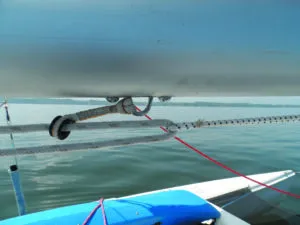
FINISHED BUNGEES
Some of our finished bungees were part of assortment packs commonly sold at hardware stores and online retailers.
PERFECT BUNGEE
Unique among the products tested, this cord (part # PC18FE) is naked polyurethane. Although minor sun damage was visible, elasticity was consistent and we did like the non-damaging polymer hooks.
Bottom line: Recommended for securing tarps and gear.
DAVIS INSTRUMENTS SHOCKLES
Belonging in a separate category, Shockles are constructed from high quality bungee material inside a polyester webbing cover, and the end hooks are either stainless-steel carabiners or u-shackles, according to the application and size. The webbing reduces the range of action, but also provides superior protection for the webbing, prevents over extension, and makes them as strong as the webbing/ shackle combination.
We’ve been using them for years to hold the rudder out of the water They’re tough and we’ve not had a failure. Heavier duty models can dampen mooring and dockline shocks (See “Controlling Motion: Two Case Studies,” PS August 2019).
Bottom line: Best Choice for high abrasion, high load applications where strength is vital and complete failure would be bad.
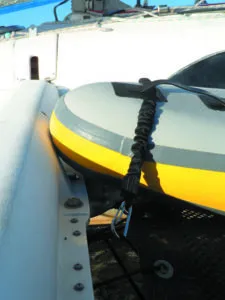
HARBOR FREIGHT BLACK RUBBER
This cord failed after two weeks when the hook ripped out under light tension, a potentially dangerous scenario.
Bottom line: Not recommended.
GRAINGER EPDM RUBBER STRAP
The sample we examined was one of 12 that had been holding a heavy duty tarp over a piece of mothballed equipment for 8 years. The company has used hundreds, if not thousands, over the years, to secure tarps on roll-off boxes. This one was constantly tensioned, holding against wind and pooled rainwater in the Ohio sun. It showed no signs of wear. On the other hand, this is a stiff strap that would pull the eyes right out of a common hardware store tarp. Many suppliers offer nearly identical straps; the constant is heavy duty construction in EPDM rubber.
Bottom line: Recommended for heavy duty use.
HARBOR FREIGHT HAULMASTER
Part of an inexpensive assortment, our test bungee failed within two weeks. After 18 months in the sun the cover was powdery.
Bottom line: Not recommended.
HOME DEPOT STANDARD BUNGEE
Although the cover was slightly weathered, integrity and stretch remained good, and we expect it to last 2-3 seasons.
Bottom line: A Budget Buy.
HOME DEPOT SUPER STRONG
This assortment pack looked like the standard bungee, but cost more. Oddly, we noted signs of failure within a year.
Bottom line: Buy the standard singles instead of the multi-pack.
CONCLUSIONS
There is clearly a huge range in quality in this field. For bulk cord, we’re staying with Sailrite when we have time, buying from West Marine when we need it. We’ll report back if we find a good source for the Dyneema covered Ronstan product. It was good stuff.
Among pre-manufactured bungees, the Davis Instrument’s shockles are pricey, but we’ve been using them hard for years and they just keep taking it, without signs of wear. For securing tarps and the like, The Home Depot and Perfect Bungee products seem reliable, but we’d skip Harbor Freight entirely. For industrial and heavy duty tarps, we’re going to stick with plain black EPDM bungees from known industrial suppliers, such as Grainger. You can make tarp bungees from quality cord and fittings, but depending how you value your time, the cost savings can be minimal.
RESOURCES
DAVIS INSTRUMENTS,
GRAINGER,
HARBOR FREIGHT,
HOME DEPOT,
NEW ENGLAND ROPES,
PERFECT BUNGEE,
RONSTAN,
TUEFELBERGER,
VALUE GUIDE: BULK SHOCK CORD
VALUE GUIDE: BUNGEE CORD
In general, knots don’t work well with do-it-yourself bungees. Line diameter shrinks and grows with each cycle, making many common knots unstable. An overhand stopper knot will slowly roll towards the end of the line, unless very well tightened.
KNOTS THAT WORK
• A series of half hitches with the tail seized will hold. (photo 1).
• Double overhand stoppers, drawn up tightly.
• Poachers knot, also called a double overhand noose (https://www.animatedknots.com/poachers-knot)
KNOTS THAT DON’T WORK

• Bowline. The line rolls and the knot inverts, coming loose.
• Figure 8. You just can’t snug it tight enough. An overhand is better.
• Sewn eyes. We’re fans for rope, but sewing a rubber core is a challenge. Still, it is one of our more common methods. For more security, use a sailmaker’s eye—a seizing at the throat and tail, with a line of basting stitches connecting the two (photo 2).
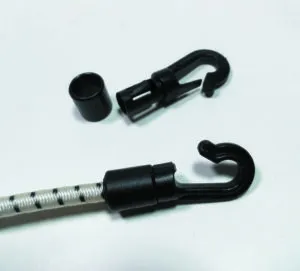
FITTINGS AND RINGS
Sailrite #369001 Self-Locking Hook. We’ve had mixed success. They work best if you cut the bungee with a hot knife and creating the largest end blob that will squeeze inside the fitting. The latches prevent accidents, but we often cut ours off for easier use.. $2.95 for a 10-pack (photo 3).
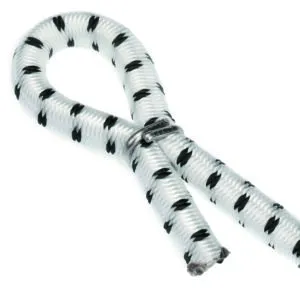
• Sailrite #29308 Plastic hook pack. These hooks (with latches like #369001) attach with a knot. Pull the knot tight to ensure it will hold under load. $13.95 for a 5-pack.
• Sailrite Hog Rings #100951 (photo 4). These are reliable as long as you use two and don’t skimp on the pressure. You will also need an $18 clamping tool.
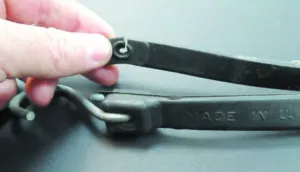
END-FITTING CAUTIONS
• Flat bungees (photo 5). Cheap premade shock cords won’t last long. The hook pulled through the Harbor Freight shock cord (top), while the Grainger bungee (bottom) is still going strong.
• Adjustable ends (photo 6). The teeth in adjustable end fittings tears up the protective cover, shortening life.
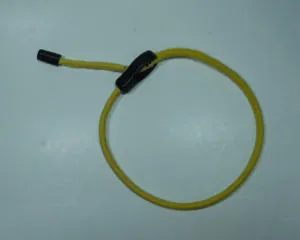
High-quality, pre-fabricated covered shock cords are relatively inexpensive and can last for years if they are not left out in the sun. However, for exposed applications, or those that require special hooks or end fittings, making your own covered shock cord can be worth the time.
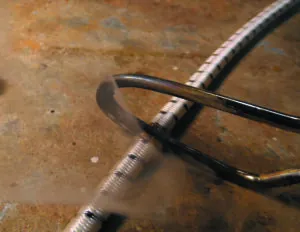
1. Using a hot-knife to cut the shock cord, makes it easier to thread the cord through the cover.
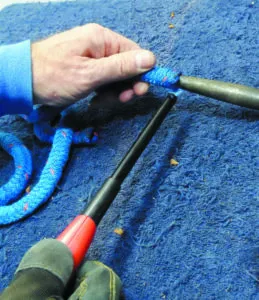
2. We melted the frayed edges of the cover before threading the shock cord.

3. After pulling out the core out of the cover of polyester double-braid line, tape the shock cord to a long fid and push it through the braided cover.
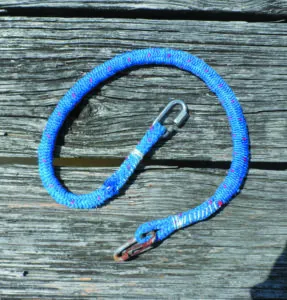
4. We stitched on some inexpensive hardware store carabiniers that can be replaced if needed. Stainless steel is an option, but not necessary.
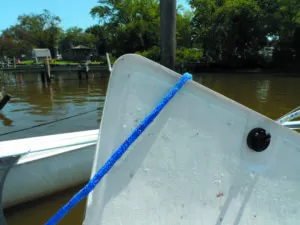
5. The cover protects the cord as it is looped over our cockpit locker lid to keep it open.




























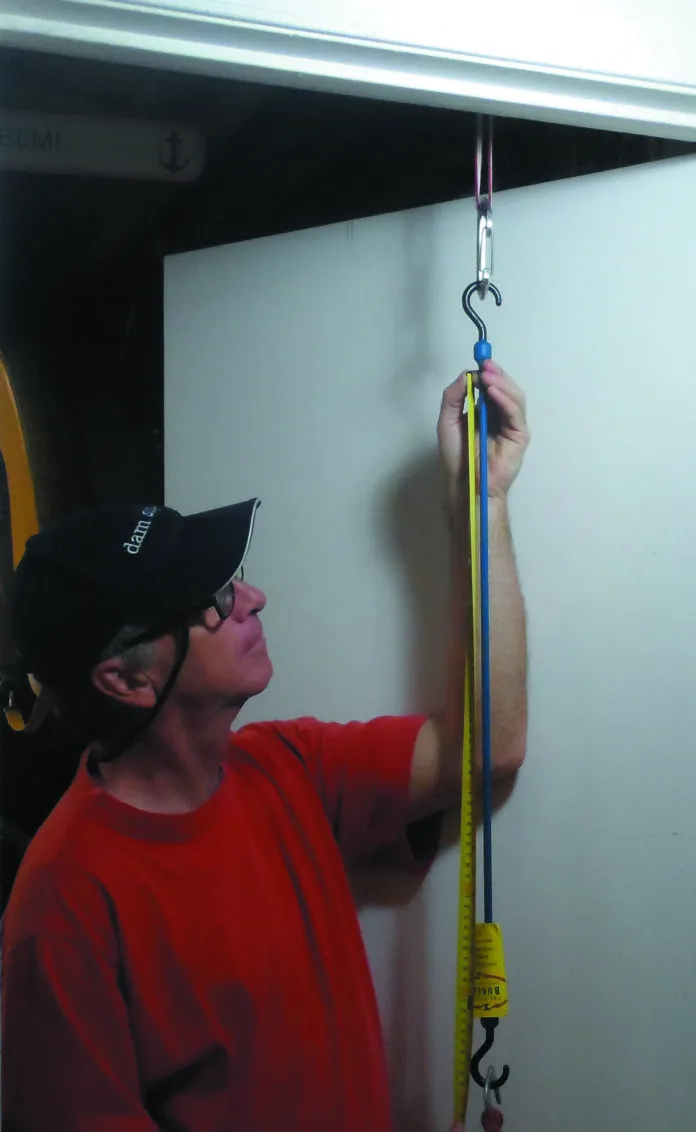






I think your proofreader missed something about discontinuing the Dyneema because if nicks in the bungee precipitating failure. Perhaps you meant solid EPDM or urethane?
Our dyneema covered bungee (sourced from Robline, another Teufelberger brand) has held up well in part sun for four years. Primary use is on intermediate bat cars for the mainsail on our catamaran.
Certainly the solid bungee was not Dyneema. But in fact, APS declined to supply us with their solid-core bungee because they were discontinuing it. It was polyurethane. We did not test it.
Robline and Ronstan cords continue to hold up well, and off-brand stuff continues to fail.
Can you clarify the meaning of the % numbers in the chart? For instance, what is 18% stretch at 10 lbs?